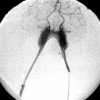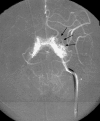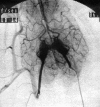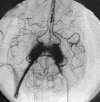Treatment of arteriovenous malformations with hydrocoils in a Swine model
- PMID: 20557757
- PMCID: PMC3313719
- DOI: 10.1177/159101990801400207
Treatment of arteriovenous malformations with hydrocoils in a Swine model
Abstract
Arteriovenous malformations (AVM) of the brain are the most common symptomatic congenital vascular malformation of the central nervous system, with significant associated morbidity and mortality. This study compared the feasibility and efficacy of treating AVMs by embolization with hydrocoils with similar treatment with bare platinum coils, using the swine rete mirabile as a model. A right carotid-jugular fistula was created in ten swine.A microcatheter was positioned into the rete mirabile, which was unilaterally (contralateral to the fistula) embolized with hydrocoils in six and bare platinum coils in four swine. Angiograms were evaluated during and immediately after embolization. Embolization with complete cessation of bloodf low in the unilateral rete mirabile was achieved in all animals treated with hydrocoils. The number of coils needed varied from four to seven (diameter 2-4 mm; mean coil length 22.3 cm). Embolization with platinum coils of similar number (seven) and slightly longer length (mean 37.75 cm) had a minimal effect on blood flow, resulting in occlusion of only small compartments. No immediate complications were noted with either coil. Hydrocoils are more effective in achieving embolization than bare platinum coils. Expansion of the hydrocoil over only a few minutes allows precise placement and stabilization of the coil before detachment. Hydrocoilscan be safely placed into small vessels. This approach may be particularly useful to decrease the flow rate, as a first stage of AVM embolizationin high flow AVMs that contain arteriovenous fistulae.
Figures









Similar articles
-
Embolization of intracranial aneurysms with hydrogel-coated coils versus inert platinum coils: effects on packing density, coil length and quantity, procedure performance, cost, length of hospital stay, and durability of therapy.Stroke. 2006 Jun;37(6):1443-50. doi: 10.1161/01.STR.0000221314.55144.0b. Epub 2006 May 4. Stroke. 2006. PMID: 16675742
-
HydroCoil as an adjuvant to bare platinum coil treatment of 100 cerebral aneurysms.Neuroradiology. 2007 Feb;49(2):139-48. doi: 10.1007/s00234-006-0166-0. Epub 2006 Nov 22. Neuroradiology. 2007. PMID: 17119947 Clinical Trial.
-
In vivo evaluation of the new PHIL low viscosity in a swine rete mirabile model.Interv Neuroradiol. 2018 Dec;24(6):706-712. doi: 10.1177/1591019918784915. Epub 2018 Jul 4. Interv Neuroradiol. 2018. PMID: 29973081 Free PMC article.
-
Endovascular management of a ruptured cavernous carotid artery aneurysm associated with a carotid cavernous fistula with an intracranial self-expanding microstent and hydrogel-coated coil embolization: case report and review of the literature.Surg Neurol. 2007 Nov;68(5):562-7; discussion 567. doi: 10.1016/j.surneu.2006.10.074. Surg Neurol. 2007. PMID: 17961748 Review.
-
Brain aneurysms and arteriovenous malformations: advancements and emerging treatments in endovascular embolization.Stroke. 2007 Apr;38(4):1411-7. doi: 10.1161/01.STR.0000259824.10732.bb. Epub 2007 Feb 22. Stroke. 2007. PMID: 17322071 Review.
Cited by
-
Dual-lumen balloon catheters may improve liquid embolization of vascular malformations: an experimental study in Swine.AJNR Am J Neuroradiol. 2015 May;36(5):977-81. doi: 10.3174/ajnr.A4211. Epub 2015 Jan 15. AJNR Am J Neuroradiol. 2015. PMID: 25593200 Free PMC article.
References
-
- Akin ED, Perkins E, Ross IB. Surgical handling characteristics of an ethylene vinyl alcohol copolymer compared with N-butyl cyanoacrylate used for embolization of vessels in an arteriovenous malformation resection model in swine. J Neurosurg. 2003;98:367–370. - PubMed
-
- Al-Shahi R, Warlow C. A systematic review of the frequency and prognosis of arteriovenous malformations of the brain in adults. Brain. 2001;124(10):1900–1926. - PubMed
-
- Angulo-Hervias E, Crespo-Rodriquez AM, et al. Progression following the embolisation of 100 intracranial arteriovenous malformations. Rev Neurol. 2006;42:8–16. - PubMed
-
- Biondi A, Le Jean L, et al. Fatal hemorrhage complication following endovascular treatment of a cerebral arteriovascular malformation. Case report and review of the literature. J Neuroradiol. 2006;33:96–104. - PubMed
-
- Bristol RE, Albuquerque FC, McDougall CG. The evolution of endovascular treatment for intracranial arteriovenous malformations. Neurosurg Focus. 2006;20:e6. - PubMed
LinkOut - more resources
Full Text Sources

